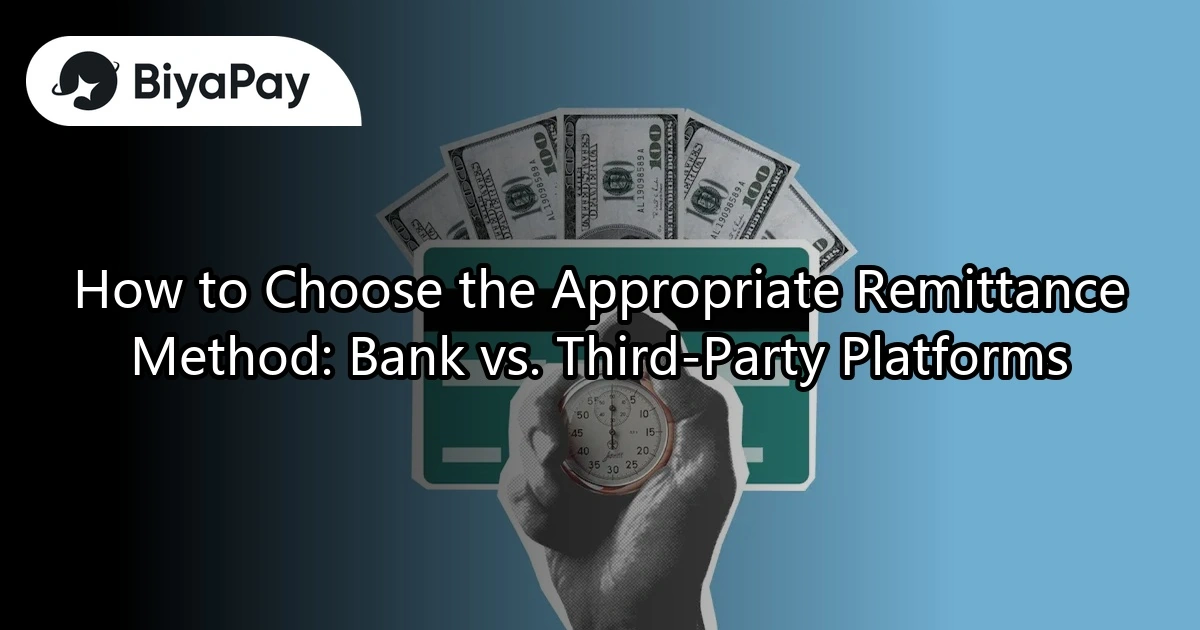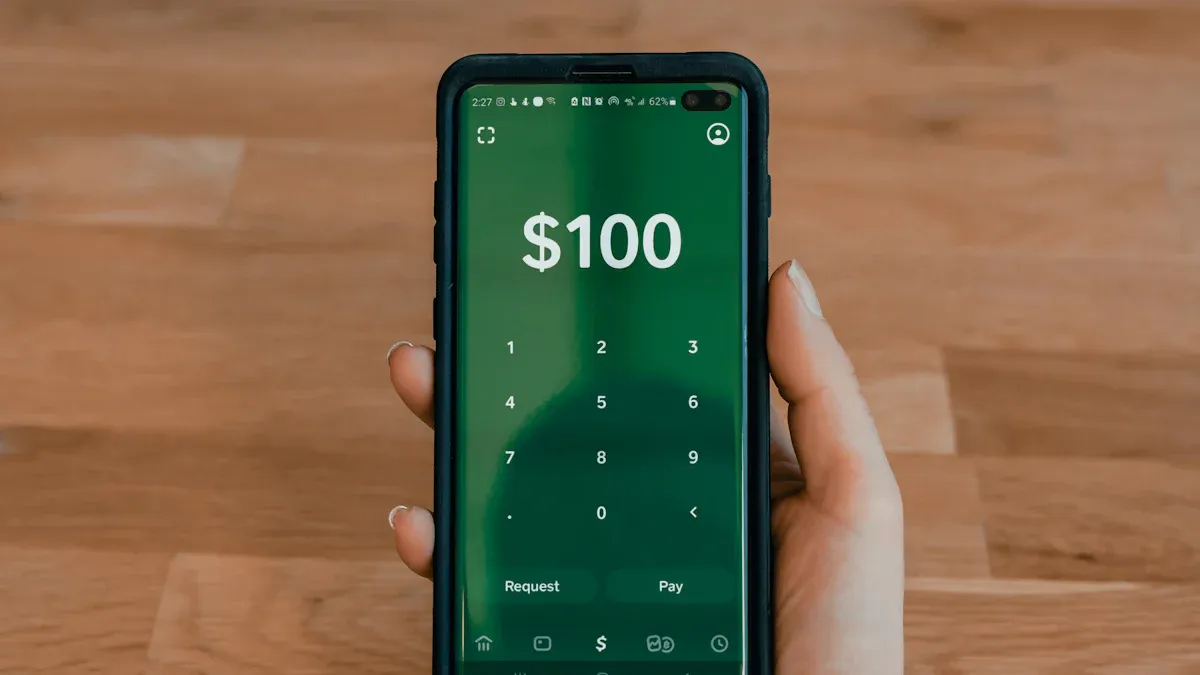- EasyCard
- Trade
- Help
- Announcement
- Academy
- SWIFT Code
- Iban Number
- Referral
- Customer Service
- Blog
- Creator
How to Choose the Appropriate Remittance Method: Bank vs. Third-Party Platforms

Image Source: unsplash
When choosing a remittance method, you need to consider the transaction amount, frequency, and personal needs. For large transactions, bank remittances are usually a safer choice. For small, frequent transactions, third-party platforms can better meet your needs. According to statistical data, the proportion of small-amount transfers (single transactions of 3,000 yuan or less) through personal online banking has decreased by 11.3 percentage points, while the proportion of large-amount transfers (single transactions exceeding 10,000 yuan) has increased by 11.6 percentage points (source). This indicates that large transactions are becoming more common, making the choice of an appropriate remittance method particularly important. For example, when studying abroad in Australia, how to balance Australia study abroad remittance fees, arrival time, and security is a key issue you need to consider.
Core Points
- When choosing a remittance method, consider the transaction amount and frequency. Large transactions are suitable for bank remittances, while small, frequent transactions recommend third-party platforms.
- Bank remittances offer high security, suitable for paying large sums such as tuition fees, but have higher fees and longer arrival times.
- Third-party platforms like PayPal and Wise provide fast arrivals and convenience, suitable for urgent payments and small transactions.
- When choosing a remittance method, comprehensively consider fees, arrival time, and security to meet personal needs.
- Ensure the correct recipient information is filled out to avoid delays or fund losses due to errors.
Analysis of Bank Remittance Methods

Image Source: unsplash
Advantages of Bank Remittances
Bank remittances have significant security and reliability in large transactions. The banking system ensures a security barrier between account systems and the internet through strict security isolation measures. The following are the specific performances of bank remittances in terms of security:
- Adopting large-scale host systems, implementing strict communication control and authorization for network access.
- During retail transactions, information transmission requires encryption and tokenization technology.
- Financial systems rely on encrypted open public internet, further enhancing the security of data transmission.
In addition, China’s banking payment system, after decades of development, has established a widely covered, safe, and efficient payment and clearing network. Currently, over 4,000 commercial banks and more than 180 payment institutions can meet the payment needs of 1.6 billion business entities and billions of consumers. The ownership rate of personal bank accounts has exceeded 95%, higher than the average level of middle- and high-income economies. This extensive coverage makes bank remittances the preferred choice for large transactions.
For scenarios with high Australia study abroad remittance fees, although bank remittances are costly, their security and reliability provide assurance for large tuition payments.
Disadvantages of Bank Remittances
Although bank remittances excel in security, their fees and arrival times are major pain points for users. The following are the shortcomings of bank remittances in terms of fees and efficiency:
- Higher fees, with single remittance fees typically ranging from 50-80 USD.
- Longer fund arrival cycles, averaging 3-4 weeks.
- For small and medium-sized foreign trade enterprises, cross-border payments often face high transfer costs and slow receipt times.
These disadvantages are particularly evident in small, frequent transactions. For scenarios requiring fast arrivals, such as paying living expenses or urgent fund needs, bank remittances may not be the best choice.
Analysis of Third-Party Platform Remittance Methods

Image Source: pexels
Advantages of Third-Party Platform Remittances
Third-party platforms perform excellently in small, frequent transactions, especially suitable for scenarios requiring fast arrivals and convenience. The following are their main advantages:
- Fast Arrival: Third-party platforms usually provide instant settlement services, allowing funds to quickly reach the recipient’s account. This feature is highly attractive to merchants and individual users, especially when urgent payments or rapid fund turnover are needed.
- Convenience: Most third-party platforms support multiple currency payments, allowing receipt of payments from different countries without opening multiple local bank accounts. This flexibility greatly simplifies the cross-border transaction process.
- User Experience: These platforms are typically designed intuitively, with streamlined payment processes, reducing operational complexity and enhancing the overall experience.
| Advantage | Description |
|---|---|
| Fast Arrival | Third-party platforms generally provide fast settlement services, improving cash flow for merchants and individuals. |
| Convenience | Supports multiple currency payments without the need to open additional bank accounts, suitable for cross-border transactions. |
| User Experience | User-friendly interface, simplified payment process, suitable for small, frequent payment scenarios. |
In regions like Africa, the usage rate of third-party payment channels is extremely high. For example, International Money Transfer Operators (IMTOs) account for 65% of offline remittance withdrawal locations. This trend indicates that the popularity of third-party platforms is continuously increasing globally.
Disadvantages of Third-Party Platform Remittances
Although third-party platforms excel in small transactions, they have shortcomings in large transactions and security. The following are their main disadvantages:
- Lower Security: Compared to traditional banks, third-party platforms rely on the internet for transactions, with relatively lower security levels. Especially in large payments, users prefer bank remittances to ensure fund safety.
- Insufficient Proof: The paperless nature of third-party platform transactions results in limited transaction vouchers, which are easily forged. This may pose risks in scenarios requiring legal proof.
- Limited Applicability: Central banks typically restrict third-party payments to small and micro-payment fields to reduce legal and financial risks.
| Aspect | Description |
|---|---|
| Security | Traditional banks use dedicated lines, offering higher security than internet-based third-party payments. |
| Proof | Paperless transaction vouchers are limited and easily forged, particularly evident in large transactions. |
| Applicability | Third-party payments are mainly used for small and micro-payments, limiting their application in large transactions. |
For scenarios with high Australia study abroad remittance fees, although third-party platforms have advantages in small payments, they may not be as safe and reliable as bank remittances for large tuition payments.
Analysis of Australia Study Abroad Remittance Fees and Applicable Scenarios
Bank Choices for Australia Study Abroad Remittances
Bank remittances are the preferred method for many students paying tuition fees. They offer high security, suitable for large transactions. You can choose Industrial and Commercial Bank of China or China Merchants Bank for international remittances. Industrial and Commercial Bank of China has high security, higher fees, and arrival times of 1 to 3 business days. China Merchants Bank has moderate fees and faster arrival times, achieving instant or within 1 business day completion.
The advantage of bank remittances lies in their reliability and stability. For scenarios requiring large tuition payments, bank remittances provide stronger fund assurance. However, bank remittances involve cumbersome procedures. You need to fill out detailed remittance information, including recipient name, address, bank account number, etc., typically requiring 21 items of information. This may increase operational complexity.
| Bank Name | Security | Fees | Arrival Time |
|---|---|---|---|
| Industrial and Commercial Bank of China | High | Higher | 1-3 business days |
| China Merchants Bank | Medium | Moderate | Instant to 1 business day |
Third-Party Platform Choices for Australia Study Abroad Remittances
Third-party platforms perform excellently in Australia study abroad remittances, especially suitable for small payments and fast arrivals. You can choose platforms like PayPal or Wise. PayPal offers high security, lower fees, and instant fund arrivals. Wise provides similar services, with arrival times typically completed within a few hours.
Compared to bank remittances, third-party platforms are more convenient to operate. You don’t need to fill out cumbersome remittance information; providing the recipient’s email or account is sufficient to complete the payment. This convenience is crucial for students, especially when urgently paying tuition or living expenses.
However, third-party platform fees may vary based on transaction amounts. For example, platforms like Western Union and Flywire typically have fees about 1,000 yuan higher than other methods. For large payments, third-party platforms may not be as cost-effective as bank remittances.
- Domestic Bank Wire Transfers: Higher fees, requiring 21 items of information.
- Credit Card Payments: Fees range from 2% to 4%, potentially facing amount limits.
- Western Union and Flywire: Higher fees, typically about 1,000 yuan more expensive than other methods.
Choosing Based on Fees and Arrival Time
When choosing a remittance method, you need to comprehensively consider fees and arrival time. Bank remittances have higher fees but strong security, suitable for large tuition payments. Traditional bank wire transfers generally have higher fees, with arrival times of 3 to 5 business days. In contrast, TransferWise and PayPal have lower fees and faster arrivals, typically within the same day or real-time.
If you need to quickly pay living expenses or urgent funds, third-party platforms are a better choice. For large tuition payments, the security and reliability of bank remittances are more suitable. Choose the most appropriate remittance method based on your specific needs.
| Remittance Method | Fees | Arrival Time |
|---|---|---|
| Traditional Bank Wire Transfer | Generally higher | 3 to 5 business days |
| TransferWise/PayPal | Lower | Same day or real-time |
Comparison of Applicable Scenarios for Bank and Third-Party Platform Remittances
Choosing Based on Transaction Amount
The size of the transaction amount directly affects your choice of remittance method. If you need to handle large transactions, bank remittances are a safer choice. Banking systems have strict security measures to effectively protect your funds. For example, when paying tuition or purchasing property, bank remittances offer higher reliability. Although fees are higher, for large transactions, these costs are worthwhile.
For small transactions, third-party platforms have greater advantages. These platforms typically offer lower fees and fast arrival services. For instance, when paying living expenses or purchasing daily necessities, using platforms like PayPal or Wise can save time and costs. You don’t need to worry about complex operational processes; payments can be completed in just a few steps.
Tip: If you’re troubled by Australia study abroad remittance fees, choose the appropriate method based on transaction amount. Bank remittances are safer for large tuition payments; third-party platforms are more convenient for small living expense payments.
Choosing Based on Transaction Frequency
Transaction frequency is also an important factor in choosing a remittance method. If you need to remit frequently, such as monthly rent or living expenses, third-party platforms are a better choice. These platforms support fast arrivals and are simple to operate. You can complete payments anytime, anywhere via mobile apps without visiting a bank.
If your transaction frequency is low, such as paying tuition or other large expenses only once a year, bank remittances are more suitable. Although bank remittances involve cumbersome procedures, their security and reliability provide greater assurance.
| Transaction Frequency | Recommended Remittance Method | Reason |
|---|---|---|
| High-Frequency Transactions | Third-Party Platforms | Fast arrival, convenient operation |
| Low-Frequency Transactions | Bank Remittances | High security, suitable for large payments |
Choosing Based on Customer Needs
Your personal needs also influence the choice of remittance method. If you prioritize security and fund assurance, bank remittances are the preferred choice. The banking system’s strict regulation and encryption technology can effectively protect your funds, especially when handling large transactions.
If you value speed and convenience, third-party platforms better meet your needs. These platforms support multiple currency payments and require no complex operational processes. For example, students can quickly complete transfers for urgent living expenses via third-party platforms.
Note: When choosing a remittance method, you need to comprehensively consider security, speed, and cost. Choose the most suitable method based on your actual needs.
Bank remittances and third-party platforms each have their advantages. Bank remittances are suitable for large transactions, offering high security and wide coverage, capable of remitting to over 200 countries via SWIFT. However, fees are higher, and arrival times are longer. Third-party platforms are more suitable for small, frequent transactions, with fast arrivals, transparent fees, and support for multiple currency payments. The following is a comparison of the two methods:
| Indicator | Wise | Bank |
|---|---|---|
| Service Scope | 50+ currencies to 70+ countries | 100+ currencies to 200+ countries |
| Fee Transparency | Real market exchange rate + one fee | Exchange rate with hidden markup + various wire transfer fees |
| Arrival Speed | Fastest instant arrival, most within 24 hours | Usually 1-5 business days |
| Security | Supervised by financial regulatory authorities | Licensed bank |
| Ease of Use | Chinese interface, convenient online account opening | May require in-person account opening, limited language support |
Choose the most suitable remittance method based on your needs. Prioritize banks for large transactions and third-party platforms for small payments.
FAQ
1. How to Determine If Bank Remittances Are Suitable for Me?
Bank remittances are suitable for large transactions or scenarios with high security requirements. If you need to pay large sums like tuition or property purchases, bank remittances are more reliable. The banking system’s security measures can effectively protect your funds, but fees are higher, and arrival times are longer.
Tip: If you prioritize security, bank remittances are the preferred choice.
2. Are Third-Party Platform Remittances Safe?
Third-party platforms have slightly lower security than banks, but most platforms use encryption technology to protect transactions. Choosing regulated platforms (such as PayPal or Wise) can reduce risks. For small payments, the security of third-party platforms is usually sufficient.
Note: Avoid using unknown or uncertified platforms.
3. How to Save on Remittance Fees?
Choosing platforms or banks with lower fees is key. Third-party platforms like Wise typically offer lower fees. For bank remittances, you can select banks with fee discounts or use specific remittance packages.
| Remittance Method | Fee Range |
|---|---|
| Bank Remittance | 50-80 USD |
| Third-Party Platform | As low as 1%-2% |
4. Which Method Should I Choose for Urgent Remittances?
For urgent remittances, third-party platforms are more suitable. They usually support instant or same-day arrivals. Bank remittances have longer arrival times, potentially requiring 3-5 business days.
Suggestion: Use platforms like PayPal or Wise for quick completion of urgent payments.
5. What Information Should I Pay Attention to When Remitting?
Ensure the correct recipient information is filled out, including name, account number, and bank code. Bank remittances typically require more detailed information. Third-party platforms only need the recipient’s email or account information.
Tip: Carefully verify information before submission to avoid delays or fund losses due to errors.
In 2025, cross-border remittances face high fees, delayed arrivals, errors in information entry, and varying suitability for transaction types, with bank transfers costing 50-80 USD and taking 3-5 days, while small transactions favor fast third-party platforms. BiyaPay delivers a seamless, cost-effective solution! Exchange over 30 fiat currencies and 200+ cryptocurrencies with real-time rate tracking to minimize volatility, enjoy fees as low as 0.5% across 190+ countries, and benefit from same-day initiated, same-day delivered transfers. Sign up for BiyaPay in just one minute to effortlessly manage tuition, living expenses, or cross-border shopping. Earn a 5.48% annualized yield on flexible savings to grow idle funds. Secured by blockchain technology and backed by U.S. MSB and New Zealand FSP licenses, BiyaPay ensures transparent, compliant transactions with minimal risks. Start today—join BiyaPay for a secure, efficient remittance experience!
*This article is provided for general information purposes and does not constitute legal, tax or other professional advice from BiyaPay or its subsidiaries and its affiliates, and it is not intended as a substitute for obtaining advice from a financial advisor or any other professional.
We make no representations, warranties or warranties, express or implied, as to the accuracy, completeness or timeliness of the contents of this publication.




Contact Us
Company and Team
BiyaPay Products
Customer Services
is a broker-dealer registered with the U.S. Securities and Exchange Commission (SEC) (No.: 802-127417), member of the Financial Industry Regulatory Authority (FINRA) (CRD: 325027), member of the Securities Investor Protection Corporation (SIPC), and regulated by FINRA and SEC.
registered with the US Financial Crimes Enforcement Network (FinCEN), as a Money Services Business (MSB), registration number: 31000218637349, and regulated by FinCEN.
registered as Financial Service Provider (FSP number: FSP1007221) in New Zealand, and is a member of the Financial Dispute Resolution Scheme, a New Zealand independent dispute resolution service provider.


















